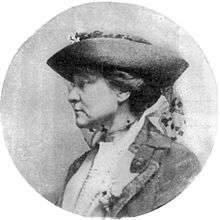Natalie Curtis

Natalie Curtis (also cited by her married name, Natalie Curtis Burlin) (born April 26, 1875, in New York City; died October 23, 1921, in Paris, France) was an American ethnomusicologist. Curtis, along with Alice Cunningham Fletcher and Frances Densmore, was one of a small group of women doing important ethnological studies in North America at the beginning of the 20th century. She is remembered for her transcriptions and publication of traditional music of Native American tribes as well as for having published a four-volume collection of African-American music.
Work
Curtis studied music at the National Conservatory of Music of America in New York City as well as in France and Germany. In Europe, she studied with prominent musicians, including Italian composer Ferruccio Busoni. After a trip to Arizona in 1900, she became fascinated with Native American music and devoted herself to the collection and transcription of such music.
Starting in 1903 she worked from the Hopi reservation in Arizona and produced transcriptions using both an Edison cylinder recorder and pencil and paper. At the time, such work with native music and language was in conflict with the policies of the Federal Bureau of Indian Affairs, which discouraged natives on reservations from speaking their language, singing their music, dressing in native garb, etc. It was only after the personal intervention of her friend President Theodore Roosevelt that she could continue her work unhindered. Roosevelt himself visited the Hopi reservation in 1913 for the Hopi flute and snake ceremonies, which visit was detailed by Curtis in "Theodore Roosevelt in Hopi Land," an article Curtis wrote for Outlook magazine in 1919.[1]
In 1905, Curtis published The Songs of Ancient America, three Pueblo corn-grinding songs with piano accompaniment. Characterizing her own task as a transcriber, she wrote, “I have in nowise changed the melodies, nor have I sought to harmonize them in the usual sense, nor to make of them musical compositions…My one desire has been to let the Indian songs be heard as the Indians themselves sing them..."[2]
Curtis published The Indians’ Book in 1907, a collection of songs and stories from 18 tribes, illustrated with handwritten transcriptions of songs as well as with artwork and photography. Most of the 200 songs are presented only in manuscript notation with no piano accompaniment at all. The book served as source for her former teacher Busoni’s Indian Fantasy, a work for piano and orchestra, first performed in 1915 by the Philadelphia Orchestra under Leopold Stokowski.
Around 1910, Curtis broadened her research to include transcription and collection of African American music, working at the Hampton Institute in Hampton, Virginia, a college established in 1868 to educate former slaves. The work was funded by philanthropist George Foster Peabody. In 1911, she and David Mannes founded the Colored Music Settlement School in New York, and in 1912 she helped sponsor the first concert featuring black musicians at Carnegie Hall, a concert that featured the Clef Club orchestra, directed by James Reese Europe.
In 1918 and 1919 Curtis (now, Curtis Burlin) published four volumes entitled Negro Folk-Songs; the volumes included spirituals, and “work-and play-songs." She published the songs in four-part harmony, a task that brought praise from composer Percy Grainger in 1918.[3] Proceeds from the volumes went to the Hampton Institute. As well, she began to study the music of African tribes and in 1920 published Songs and Tales from the Dark Continent, in which she notated the written example of what is known as the standard pattern in ethnomusicology, and triple-pulse son clave in Afro-Latin music (1920: 98). In 1917 she had married artist Paul Burlin; they moved to France, where she died in a traffic accident in 1921.
Her published work often did not appear in “scholarly journals” of anthropology or folklore. She published, for example, in Southern Workman, The Craftsman, and The Outlook, as well as in general musical publications such as Musical America. Reviews of her work appeared in such magazines as well as in standard scholarly journals of the day.[4]
Original compositions
Curtis Burlin may be considered among a small group of US American composers who used native American material in her own compositions. Others are Charles Wakefield Cadman, Arthur Nevin, and Thurlow Lieurance. She composed about 15 short, original works, many based on native American or African American themes.
See also
References
- ↑ Curtis, Natalie (March 5, 1919). "Mr. Roosevelt and Indian Music: A personal reminiscence". The Outlook: 399–400.
- ↑ Rahkonen, Carl (Autumn 1998). "Special Bibliography: Natalie Curtis (1875-1921)". Ethnomusicology. 42 (3): 511–522.
- ↑ Grainger, Percy. “Mrs. Burlin’s Study of Negro Folk-Music” in the New York Times Book Review, April 14, 1918.
- ↑ For example: Unsigned review of "Negro Folk Songs", book I in The Journal of Negro History, Vol.3, number 3, July 1918. pp. 330-331.
External links
- "Natalie Curtis Burlin"
- "Frank Mead: 'A New Type of Architecture in the Southwest,' Part II, 1907-1920" for much on the life long friendship of Natalie and George Curtis with architect Frank Mead.